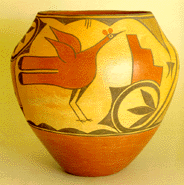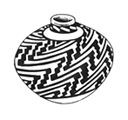|
Pueblo
Pottery Restoration and Conservation of Prehistoric Anasazi, Historic
1700s to 1900s, and Contemporary






 

 







|
|
Pueblo
Pottery Restoration
Conservation of The Past
PREHISTORIC ANASAZI *
HISTORIC
and CONTEMPORARY
PUEBLO POTTERY
Casey
Reed 505-344-8492
|
 |
Conservation
and restoration of ceramics is keyed to several levels of analysis:
- Evidence
of the original manufacture.
- Wear
patterns or damage to it from original use.
- Lastly,
evidence of modification of the ceramic or damage from the collector
or non native use which includes restoration that itself can take
its toll on altering the original ceramic.
These
ceramics, as are all low fire ceramics, are very delicate and the paints
are often attenuated or easily removed by washing or sanding and many
other procedures during the restoration process. A virtual nightmare
when we consider the art and surface survived about a thousand years
just to be damaged and frequently over-painted by the person "restoring"
the artifact-ceramic.
Ways to
restore the aesthetic qualities while preserving the past:
- The
ceramic material we use for replacement of shards or missing areas
is almost as strong as the original ceramic, but still water soluble.
It can easily be removed to reveal the original. This is not
possible with plaster especially dental plaster that is frequently
used.
- All
the paints have been custom formulated with pure conservation grade
acrylic base material from Germany.
- The
pigments are from all over the world and are the purist and highest
quality available. No commercial paints are used.
- Our
goal is to preserve the past! This working guideline dictates original
material is not to be modified, patched over, or painted.
- Archaeological
illustrations are done with major collections upon request. We first
do a technical one to one drawing in direct compliance with The
Guide to Archaeological Illustrating second revised
edition, by Brian D. Dillon. Then a one to one graphical reconstruction
of the ceramic/artifact is created on another sheet of mylar with
rapidograph pens and ink and this completed form makes it possible
to appreciate the entire painted surface of the object at a glance.
They are technically very accurate and quite beautiful! The best compliment
to the artist's hand or the finish artwork concerning these rendered
inkings is that one viewing the inking is not being able to see the
artist's bias. This is done in the pursuit of a true representation
of the original work.
- To make
all restorations objectively identifiable a UV light, a marker is
incorporated in the paints we make. The UV marker is not
visible in daylight or normal viewing light. All restored surfaces
are detectable in a 354nm light. It became necessary to develop this
feature because our restorations are undetectable or "invisible."
This feature in the paint makes all restoration visible and easily
identifiable with UV light.
- Every
innovation and practice is in the spirit and practice of conservation
and restoration with the highest respect for the original work. Our
job is to preserve the past first, and second to restore the art to
its original appearance.
Additional
Information: Call Casey Reed 505-344-8492

|


